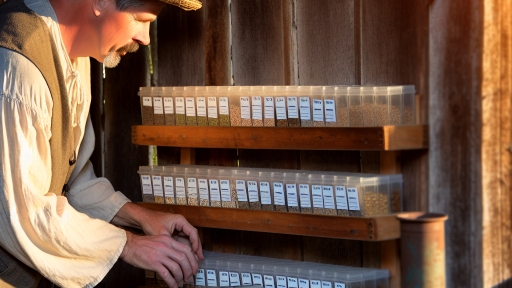Introduction to Crop Rotation
Definition of Crop Rotation
Crop rotation refers to the practice of alternating different crops in the same field.
This method prevents pest accumulation and improves soil health.
By rotating crops, farmers can disrupt cycles of diseases and parasites.
Importance of Crop Rotation for Organic Farmers
For organic farmers, crop rotation is essential for maintaining biodiversity.
This technique enhances nutrient cycling within the soil.
Additionally, it reduces reliance on chemical fertilizers.
Beneficial Effects on Soil Health
Crop rotation improves soil structure and fertility.
It helps in minimizing soil erosion and depletion.
Moreover, different crops contribute various organic matter types to the soil.
Pest and Disease Management
Crop rotation significantly reduces pest populations.
By planting different species, farmers disrupt pest lifecycles.
This approach also helps in managing crop diseases effectively.
Maximizing Yield and Productivity
Implementing crop rotation can lead to increased yields.
Diverse cropping systems improve overall farm productivity.
Farmers often notice healthier plants with better growth rates.
Transform Your Agribusiness
Unlock your farm's potential with expert advice tailored to your needs. Get actionable steps that drive real results.
Get StartedBenefits of Crop Rotation: Enhancing Soil Health and Fertility
Improving Soil Structure
Crop rotation significantly improves soil structure.
This practice encourages the development of beneficial soil organisms.
Additionally, it helps reduce soil compaction caused by heavy machinery.
Enhancing Nutrient Cycling
Different crops require different nutrients from the soil.
By rotating crops, farmers can naturally replenish these nutrients.
This helps maintain optimal soil fertility over time.
Moreover, legumes contribute nitrogen to the soil, enriching it for subsequent crops.
Reducing Pest and Disease Incidence
Crop rotation disrupts pest and disease cycles effectively.
Pests that thrive on specific crops cannot easily find food in rotated fields.
This reduces the chance of pest outbreaks and disease prevalence.
As a result, farmers can decrease their reliance on chemical pesticides.
Encouraging Biodiversity
Implementing diverse cropping systems benefits the overall ecosystem.
Different plants attract various beneficial insects and pollinators.
This biological diversity enhances resilience against environmental changes.
Furthermore, it supports a wider range of soil microorganisms.
Improving Crop Yields
Research shows that crop rotation can lead to higher yields.
Diversifying crops improves overall soil health and crop performance.
Farmers experience enhanced productivity and profitability through well-planned rotations.
Healthy soil translates directly to healthy plants and bountiful harvests.
Key Principles of Effective Crop Rotation for Organic Farming
Understanding Crop Rotation
Crop rotation is a fundamental practice in organic farming.
This method involves alternating the types of crops grown in a specific area.
Additionally, it helps to improve soil health and reduce pest issues.
Enhancing Soil Fertility
Crop rotation helps maintain soil fertility naturally.
Certain crops, like legumes, enrich the soil with nitrogen.
Showcase Your Farming Business
Publish your professional farming services profile on our blog for a one-time fee of $200 and reach a dedicated audience of farmers and agribusiness owners.
Publish Your ProfileIn contrast, other crops reduce nutrient depletion by drawing different minerals from the soil.
Breaking Pest and Disease Cycles
Switching crops disrupts the life cycles of pests and diseases.
For example, planting a non-host plant can limit pest populations.
Moreover, rotating crops can prevent the buildup of pathogens in the soil.
Supporting Biodiversity
Crop rotation enhances biodiversity on the farm.
It creates diverse habitats for beneficial insects and microorganisms.
Healthy ecosystems contribute to natural pest control and pollination.
Planning Rotation Schedules
Creating a successful rotation plan requires careful consideration.
Farmers should assess their soil types and climate conditions.
They should also select crops that complement one another.
Implementing Cover Crops
Including cover crops in rotation can improve soil health.
These plants prevent erosion and enhance organic matter in the soil.
Furthermore, cover crops can suppress weeds while promoting biodiversity.
Monitoring and Adjusting Practices
Regular monitoring is essential for effective crop rotation.
Farmers must observe crop performance and soil conditions.
Adjusting crop choices based on these observations can maximize benefits.
Uncover the Details: Selecting Seeds For Maximum Crop Yield
Common Crop Rotation Systems Used by Organic Farmers
Benefits of Crop Rotation
Crop rotation enhances soil fertility.
It reduces pest and disease pressure.
Additionally, it improves crop yields over time.
Simple Rotation Plans
Organic farmers often implement simple rotation plans.
One common system involves alternating legumes with grains.
This approach enriches soil nitrogen and diversifies crops.
Legume and Grain System
Start with legumes such as beans or peas.
After the legume phase, follow with a cereal crop.
Examples of cereals include wheat and barley.
This system supports healthy soil and stable yields.
Multi-Crop Systems
Some farmers prefer more complex rotation systems.
Multi-crop systems incorporate multiple plant families.
This complexity fortifies soil structure and diversity.
Brassicas and Grains
Introducing brassicas like cabbage can improve soil health.
Rotate these with grains for optimal nutrient balance.
Such systems break pest cycles effectively.
Cover Crops in Rotation
Cover crops play a vital role in crop rotation plans.
They protect the soil during off-seasons.
Additionally, they add organic matter to the soil.
Examples of Cover Crops
Common cover crops include clover and vetch.
These legumes fix nitrogen, benefiting subsequent crops.
Farmers integrate them between main crop cycles for maximum advantage.
Seasonal Rotation Strategies
Timing is crucial in crop rotation planning.
Showcase Your Farming Business
Publish your professional farming services profile on our blog for a one-time fee of $200 and reach a dedicated audience of farmers and agribusiness owners.
Publish Your ProfileMany farmers adapt their rotations to local climates.
Crop choices vary based on seasonal conditions and market demands.
Warm-Season vs. Cool-Season Crops
Warm-season crops thrive in summer heat.
Cool-season crops grow well in the cooler months.
Strategically alternating these crops maximizes productivity.
Long-Term Health of Cropping Systems
Sustainable rotation practices ensure long-term soil health.
Farmers continually assess soil conditions and crop performance.
Adjusting the rotation plan fosters resilience against climate variations.
Monitoring and Adaptation
Farmers regularly sample soil to check nutrient levels.
This data helps refine crop choices and timing.
Continuous adaptation leads to improved farming outcomes.
Delve into the Subject: Organic Seed Saving Techniques For Farmers
Selecting the Right Crops
Understanding Crop Needs
Before choosing crops, evaluate soil conditions carefully.
Different plants thrive in distinct soil types.
Additionally, consider the nutrient needs of each crop.
Some crops require specific pH levels for optimal growth.
Climate Considerations
Climate plays a crucial role in crop selection.
Identify the local climate zones in your area.
For instance, some crops flourish in cool temperatures.
Others need warm conditions throughout their growing season.
Pest and Disease Resistance
Select crops with natural resistance to pests and diseases.
This choice helps reduce reliance on harmful chemicals.
Rotate crops with different pest profiles to disrupt cycles.
Moreover, resilient crops can reduce overall management costs.
Market Demand and Economic Viability
Assess the market demand for various crops.
Consider growing what consumers actively seek.
Price fluctuations can significantly impact profitability.
Thus, conducting market research is essential.
Companion Planting Benefits
Utilize companion planting principles in your rotation plans.
Some plants naturally repel pests when grown together.
Moreover, certain crops can enhance each other’s growth.
Carefully consider which combinations to implement.
Crop Diversity and Soil Health
Incorporate a diverse range of crops in your rotation.
Diverse planting improves soil structure and nutrient availability.
It also reduces the risk of crop failure due to disease.
This practice supports healthy microbial activity in the soil.
Timing and Maturity Rates
Evaluate the maturation timelines of selected crops.
Some crops mature quickly and can be harvested early.
Others may take a full growing season or longer.
Plan your rotation schedule based on these factors.
Showcase Your Farming Business
Publish your professional farming services profile on our blog for a one-time fee of $200 and reach a dedicated audience of farmers and agribusiness owners.
Publish Your ProfileUncover the Details: Best Edible Plants for Sustainable Farming

Integrating Cover Crops in Rotation Plans
Benefits of Cover Crops
Cover crops enhance soil structure significantly.
They reduce soil erosion by protecting the top layer.
Additionally, they improve water retention in the soil.
These crops also contribute organic matter to the soil.
Moreover, they can fix nitrogen, enriching the nutrient profile.
Choosing the Right Cover Crops
Selecting suitable cover crops is essential.
Consider the climate and soil type of your farm.
For instance, clover thrives in cooler climates.
On the other hand, sorghum-sudangrass grows well in warmer areas.
Moreover, interseeding can optimize land use.
Timing and Management
Timing plays a critical role in cover crop effectiveness.
Plant cover crops after the main harvest to maximize benefits.
Manage them through timely mowing or grazing.
This approach prevents excessive growth and seed production.
Subsequently, incorporate them into the soil before planting main crops.
Monitoring Soil Health
Regularly monitor soil health to assess improvements.
Soil tests can provide insights into nutrient levels and structure.
Observe changes in water infiltration and retention rates.
Additionally, note any shifts in pest populations and biodiversity.
These observations can inform future crop rotation plans.
Uncover the Details: Beginner’s Guide to Mushroom Farming on Small Farms
Case Studies: Successful Organic Crop Rotation Strategies
Farmers’ Perspectives
Organic farmers often share valuable insights on crop rotation.
They adapt their strategies based on soil health and crop needs.
For instance, Emily Thompson operates a 50-acre organic farm in Iowa.
She rotates between corn, soybeans, and cover crops each year.
This practice enhances her soil’s nutrient content significantly.
Benefits of Crop Rotation
Crop rotation reduces pests and diseases effectively.
It also improves overall soil structure and fertility.
Farmers notice a decline in specific pest populations with rotation.
Moreover, growing different crops enhances biodiversity on the farm.
Real-World Applications
Tomas Santiago runs an organic vegetable farm in California.
He uses a three-year rotation plan involving tomatoes, cucumbers, and beans.
This strategy maximizes soil health while minimizing pest issues.
In addition, the crop mix provides continuous harvests throughout the seasons.
Community-Based Approaches
Community farms often collaborate for shared rotation plans.
The Green Valley Collective in Oregon implements combined strategies.
Farmers exchange knowledge and crop choice data regularly.
These partnerships enhance community resilience and productivity.
Challenges Faced
Transitioning to new crop rotation can be challenging initially.
Showcase Your Farming Business
Publish your professional farming services profile on our blog for a one-time fee of $200 and reach a dedicated audience of farmers and agribusiness owners.
Publish Your ProfileFarmers must learn and adapt to changes in planting schedules.
Additionally, market demand can impact crop selection decisions.
Nevertheless, many farmers find that benefits outweigh initial hurdles.
Future Trends in Crop Rotation
Innovative technologies are shaping the future of crop rotation.
Data analytics help farmers make better decisions about crops.
Remote sensing can track crop health and soil conditions effectively.
As a result, farmers can optimize their rotation strategies continuously.
Successful Organic Crop Rotation Strategies Promoting Sustainability
Successful organic crop rotation stands as a testament to sustainable farming.
Many farmers highlight improvement in yields and sustainability.
Ultimately, these diverse strategies foster healthier ecosystems.
Challenges and Solutions: Overcoming Obstacles in Implementing Crop Rotation
Understanding Common Challenges
Implementing crop rotation presents various challenges for organic farmers.
Soil fertility can decline when transitioning from monoculture systems.
Pests and diseases may adapt to new crops, creating management issues.
Additionally, timing and logistics complicate planting schedules.
Farmers often struggle with limited knowledge about diverse cropping systems.
Developing Effective Solutions
Implementing education programs enhances farmer understanding of crop rotation.
Workshops can provide practical advice tailored to local conditions.
Partnering with agronomists helps farmers develop personalized crop rotation plans.
Utilizing cover crops improves soil health and mitigates pest issues.
Farmers can also benefit from collaborating within local farming networks.
Building Community Support
Community support plays a crucial role in implementing crop rotation successfully.
Networking with other farmers provides valuable insights and shared experiences.
Local cooperatives can assist in resource sharing and coordination.
Moreover, advocacy groups can promote the benefits of crop rotation to policymakers.
Building a supportive community fosters a more resilient farming environment.
Continuously Adapting and Learning
Regular evaluation of crop rotation outcomes informs future strategies.
Farmers should document their experiences to refine their approaches over time.
Additionally, staying informed about new research enhances adaptive management.
Farmers should embrace flexibility in their planning and implementation.
This mindset promotes resilience in the face of changing conditions.
Additional Resources
The Three Sisters of Indigenous American Agriculture | National …
small scale agriculture – LaFarm, The Lafayette College Community …




